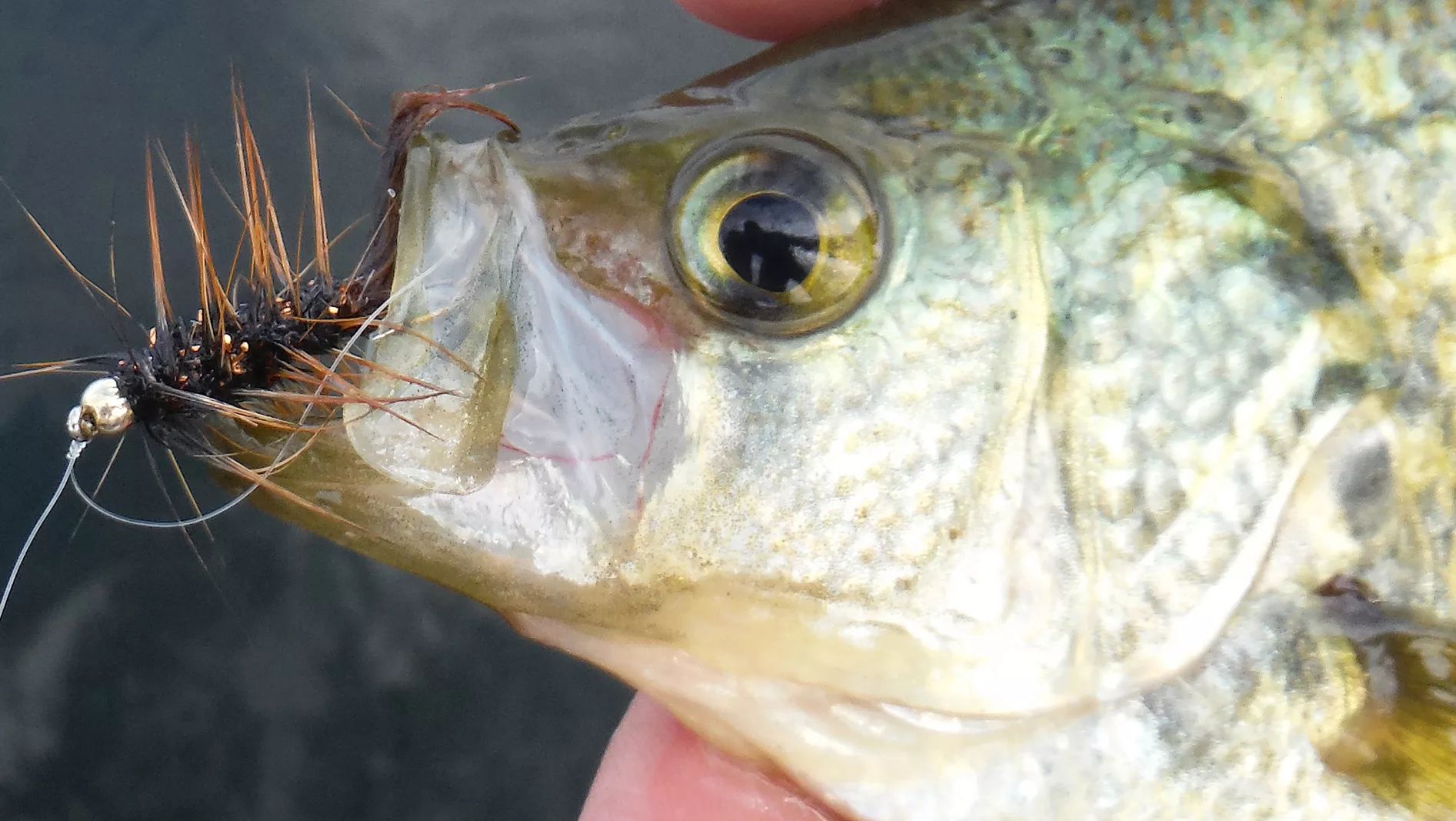
Crappies will take to flashy woolly buggers on the fly rod and make a great warm-water target. Simonson Photo.
By Nick Simonson
With the heat of summer finally settling into the region, those cold-water loving trout which were stocked in area lakes and reservoirs are seeking out the depths, and aside from some cooler hours in the morning and evening, are a bit tougher to target on the fly rod and likely will remain that way until early fall. Luckily, around the upper Midwest, there are plenty of other fish to take their place on the long rod and many ways to catch them. What follows are five warm water species to take on with a fly box in tow, hone those fly fishing skills and have a blast all summer long, until things cool down in autumn and trout rise back up into the shallows.
Panfish Plan
No summer would be complete without a warm afternoon in the shallows chasing bluegills, and these feisty panfish give every fly angler a reward for their cast, whether curled tight and well-practiced, or a little shaky when just starting out. Work the inside edge of weedlines, especially those in shallow bays or along warm sandy beaches that can easily be waded, or cast parallel to them from a boat on the outer edge. Watch for rising fish that are snapping at whatever’s hatching, but don’t be worried about matching those little bugs. Bluegills will take all sorts of flies from complex dries to basic nymphs to simple foam bugs, but favorites include beetles and rubber-legged spider patterns.
Brown Bombers
For a summertime fight, nothing puts forth its best effort like a smallmouth bass; now double that intensity level if they’ve been hooked on the fly rod. Their acrobatic leaps and hard runs after splashdown will test drag and line management and teach the art of bowing – that is, lowering the tip of the rod to a jumping fish – to prevent them from slingshotting the hook loose from their jaws. While most active in the early morning and late evening light on shallow rock bars, gravel shoals and sandy stretches of the lakes and streams where they reside, these brown bass can be encountered any time of day along these structures and others. Offer up large baitfish patterns that can be ripped past them and trigger a reaction strike, like Lefty’s Deceiver or toss a crayfish-colored Clouser minnow out there and bump it along the bottom for a solid take.
Specks of Summer
In a lake loaded with crappies, those low light conditions at the end of the day are the best bet for hooking a series of slabs on the fly rod. During the day though, crappies can be found along weed edges and may require a sinking style line, such as a Type III, to get down to them. With their quick inhale of any fly, slabs can test the focus of even the most attentive fly angler, so watch that line carefully for a slight twitch or jump to signal a take by a crappie on the feed. As night approaches, look for crappies to rise in the column – sometimes to just below the surface – to snack on whatever imitation you have to throw at them. Anything that looks like a minnow will work, including Clousers, white, silver, or other flashy woolly buggers, and even crazy Charlie streamers.

White Lightning
A school of white bass is a summertime treasure as these silver-sided fish swarm and smash just about anything pulled in their direction. Look for splashing along the surface for active fish and get as close as possible without spooking the school. Drop a cast just beyond the group and strip a streamer of any sort directly through them – but hold on! The jarring take from a white bass can rip a five-weight from even the tightest grip. With their sprints and circular runs, white bass will put it to any angler’s drag and help teach a whole new level of line management. Look for those lakes where current year classes are topping 15 inches for some of the most exciting and consistent adventures with the fly rod. Bucktail streamers like the Thunder Creek work well when white bass are up top, and any pattern with a little weight to it, like the Half-and-Half will get down to a school when they’re feeding deeper.
Rough ‘Em Up
Carp get a bad rap among anglers until they hook one on the fly rod. Then it’s fifteen minutes of a doubled-over five weight trying to steer thirty inches of scales and stink into the shallows for a slimy photo opportunity, grinning ear-to-ear with a bested “golden bonefish.” Where these rough fish abound, so do some of the most exciting and prolonged flyfishing events of the summer. Look for carp that are slurping the surface and lay out a cast and get ready for a fun fight on the fly rod but be sure to keep your distance to avoid spooking them. Offer up small nymph patterns or woolly buggers to connect, and in those areas where mulberries make their way into the water along the shore at midsummer, add a few purple foam patterns to the fly box to tangle with the region’s swimming garbage can that’ll eat just about anything from top to bottom in the water column.
Just because you don’t have a mountain stream nearby, and the region’s stocked trout have taken to the depths, doesn’t mean fly fishing season is over. Use the options around you to sharpen those skills – whether newly-acquired or long-held – and heat things up with these great warm water species to catch on the fly…in our outdoors.
